Time To Learn How To Fly RC Helicopters
by John Salt (Certified MAAC RC Heli Instructor) - Updated April 2025
Welcome to my flight school!
You are about to learn how to fly RC helicopters. Yes you can do it! But it does take time, patience, & perseverance. Those three are up to you.
It also requires instruction, tips, & a methodical ground up learning process. Those three I'll help you with.
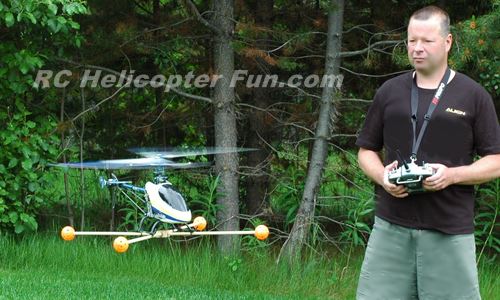 Learning How To Fly RC Helicopters Requires Lots Of Concentration
Learning How To Fly RC Helicopters Requires Lots Of ConcentrationAll the research deciding on your best RC helicopter, purchasing it and learning all about the controls has brought you to this stage.
You should be proud of yourself - good job! As fun as that entire process was, now it gets really fun!
This is without doubt the most important section of this entire website, and I can't stress this next point enough.
It's estimated over 50% of all single rotor collective pitch RC helicopters sold to first time fliers end up crashing within the first minute (seconds usually) of their maiden flight.
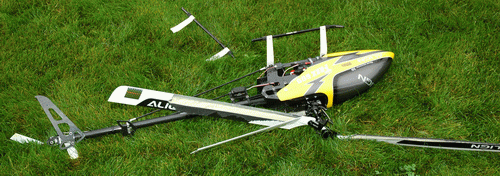 This Is Not What You Want To Do!
This Is Not What You Want To Do!I am not trying to scare you off, I just want you to understand how important it's to get proper instruction. If you don't have access to a good RC heli instructor or an experienced flier, this is where I hope I can help you out. :-)
I have both written instructions along with video demonstrations on all the day lesson plans for two methods of learning how to fly RC helicopters. I do however strongly recommend reading & watching to get as much information out of the lessons as possible.
Hopefully I can help you be on the other end of that 50%, the successful end. Please take the time to read, watch, and understand every part.
Learning how to fly RC helicopters is a very systematic and methodical process that you can’t rush! If you do, crashing is the guaranteed outcome.
I should point out these lessons are geared towards people who are learning to fly single rotor collective pitch RC helicopters, not toy helicopters, micro coaxial RC helicopters, or quad/multi-rotor.
Those types of helis are pretty easy to fly and you don’t really need a formal lesson plan. That said - first time fliers of these simple, easy to fly helis will get some useful advice out of parts of the lessons (tail in orientation being the biggest one), so feel free study them.
How Long Will This Take?
The very first thing that you have to realize is you will not learn how to fly a single rotor collective pitch RC helicopter in one day.
That is totally unrealistic and if you think that way, you are setting yourself up for disappointment.
Your number one main goal is to bring your helicopter home in one piece each time you go out.
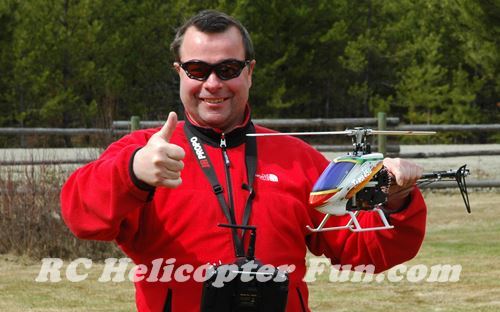 Heli Comes Home In One Piece!
Heli Comes Home In One Piece!This is very possible if you take small progressive steps.
While I have instructed others how to fly RC helicopters; rarely did any these people ever crash while learning to hover. The fact is if you set up your RC helicopter correctly, learn from the ground up, and don’t rush, you won’t crash either.
I also never used a trainer cord / buddy box. Every person learned on his/her own radio with me standing beside them giving instructions and advice.
This is how I will teach you.
That is the single biggest difference between learning how to fly an RC airplane, and learning how to fly an RC helicopter. When learning to fly an RC plane for example, you are committed to flight the first day out, the second your plane leaves the ground. This is where buddy box instruction pays huge dividends since your plane is now airborne and traveling at a fast rate of speed at a fairly high altitude.
RC helicopters are however very different in the way you learn to fly them.
With an RC helicopter, you are not "committed" to flight like you are with a plane. It's totally up to you if & when want to leave the ground, how high off the ground you get, and how long you stay in the air.
This is where learning to fly a heli is actually easier and less stressful. We start by barely floating (called "light on the skids"), then progress to short hops as we gradually increase the time spent in the air. It's all very manageable and safe!
Any time you are feeling the least bit uncomfortable, throttle/collective back and you are safely back on the ground.
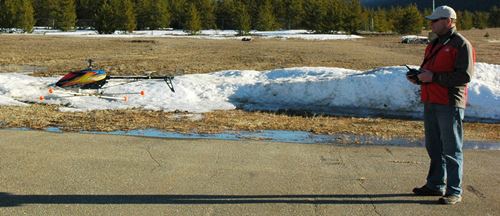 Low Hover Training + Tame Setup = Hard To Get Into Too Much Trouble!
Low Hover Training + Tame Setup = Hard To Get Into Too Much Trouble!Hovering a helicopter is also very much a balancing act with constant and multiple stick corrections happening all the time. You can't learn that well from a buddy box. You'll learn much quicker and more successfully when you gradually "feel" your way into how the heli is behaving and reacting.
You first learn control movements while on the ground, and then progress to small incremental "hops", getting a feel for the "balancing act" while airborne. Eventually achieving a sustained & controlled hover at a very safe distance above the ground (no more than a foot or two).
Crashing is all but impossible if you take this "ground up" learning approach and have a tame learning to hover setup.
It takes people several days or even weeks to learn how to hover and progress into forward flight. This is how I have arranged your RC helicopter flying lessons – I have broken them down into a 10 day course.
Some day lessons will only take you minutes to master, most will take hours, and some could take days, weeks, or even months depending on your natural abilities and how much time you put into practicing. The more you practice, the quicker you'll learn - just like any other skill.
The number one thing to remember when learning how to fly RC helicopters is not to progress to the next day’s lesson plan until you are 100% comfortable and confident with the step you are currently learning.
These day lessons shouldn’t be taken too literally. As I mentioned, some people catch on fast; others take more time – progress at your own speed. Do I need to say this one more time – don’t rush & the primary goal is to always bring your helicopter home in one piece!
Needing Help With Your Collective Pitch Setup As You Learn To Fly?
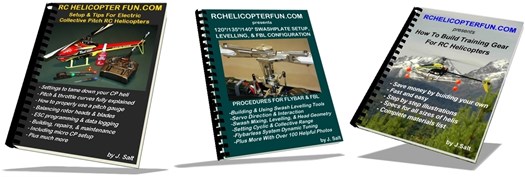 Collective Pitch Essentials Combo eBook Package Saves You 25% Off Individual Pricing.
Collective Pitch Essentials Combo eBook Package Saves You 25% Off Individual Pricing.If you are self learning how to fly a collective pitch RC helicopter and need help with your setup to ensure everything is correct & tamed down for learning on; I offer this specific "Collective Pitch Essentials" eBook combo package at 25% off the regular eBook pricing.
Included in the package are:
- Setup & Tips For Collective Pitch RC Helicopters
- Swashplate Setup, Levelling, & FBL Configuration
- How To Build RC Helicopter Training Gear
These are the three most popular eBooks that beginners purchase when they are self learning how to fly a collective pitch RC helicopter so to help you save a few bucks, here they are at a bundled price.
$27.00 USD (Regular price if purchased separately: $35.85 USD)
So are you ready to start learning how to fly RC helicopters? Flight School is in!
- DAY 1 – Pre Flight Setup
- DAY 2 – Dynamic Pre Flight Adjustments
- DAY 3 – Ground Hover Exercises
- DAY 4 – Low Hover Exercises
- DAY 5 – Hover Figure 8
- DAY 6 – Nose Pointing In Direction Of Flight Figure 8
- DAY 7 – Slow Forward Circuit Around Pilot
- DAY 8 – Forward Flight & Translational Lift
- DAY 9 – Flying A Large Figure 8 Circuit
- DAY 10 – Nose In Hover
- Aerobatics & 3D
The first 10 days/lessons are your most important while learning to fly RC helicopters. Once you have mastered all ten days you'll be able to comfortably and confidently control and fly your RC helicopter in what we call scale or general type flying. No fancy aerobatics, just smooth controlled flying like a real helicopter in all upright orientations.
As a MAAC (Model Aeronautics Association of Canada) RC helicopter instructor, this is also when I & a club executive member would sign you off with your Level D helicopter certificate. A very big & rewarding accomplishment for most!
Day 10 (the nose in hover) is actually part of the next and final Advanced Level certification, but I like my students to learn the nose-in because it really opens up the possibilities. It's also a good indicator if the student has the ability to progress to aerobatics because if a person can't master the nose in hover in an upright orientation, there is no way they will be able to cope with inverted orientations.
If & when you're ready to progress to RC helicopter aerobatics & 3D , the last "Aerobatics & 3D" lessons covers those more advanced lessons.
If you're practicing on an RC flight simulator too, that is great. Just remember to follow along with these same lesson plans on your simulator. This will make stick time on your real RC heli much more productive if you have practiced each lesson plan before hand on the simulator.
Good Luck & Success With Your RC Helicopter Lessons!









